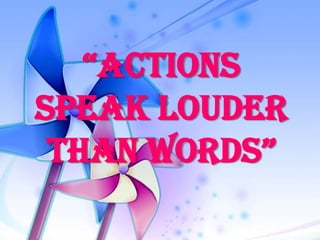
Public speaking
- 1. “Actions Speak Louder thAn Words”
- 3. In public speaking, your body can be an effective tool for adding emphasis and clarity to your words. It’s also your most powerful instrument for convincing an audience of your sincerity, earnestness, and enthusiasm. However, if your physical actions are distracting or suggest meanings that do not agree with your verbal message, your body can defeat your words. Whether your purpose is to inform, persuade, entertain, motivate, or inspire, your body and the personality you project must be appropriate to what you say.
- 4. Gesture • is a form of non-verbal communication in which visible bodily actions communicate particular messages. Gestures include movement of the hands, face, or other parts of the body. • allow individuals to communicate a variety of feelings and thoughts.
- 5. Gestures can be used to: a. emphasize the point you are making –shaking your fist to show you are serious; making an OK or victory sign with your fingers b. suggest something –shrugging the shoulders to show that you don’t know c. describe –acting as if you are falling to describe that you fell face first into the water d. prompt - clapping your hands to make your audience also clap
- 7. Stand straight but not rigid, with your feet about six to 12 inches apart and one slightly ahead of the other. Balance your weight evenly on the balls of your feet. Lean forward just a little. Your knees should be straight but not locked. Relax your shoulders, but don’t let them droop. Keep your chest up and your stomach in. Your head should be erect and your chin up, but not uncomfortably so. Let your arms hang naturally at your sides, with your fingers slightly curled.
- 9. When you speak, your face communicates your attitudes, feelings, and emotions more clearly than any other part of your body. According to behavioral psychologists, people can easily recognize – simply by observing a speaker’s facial expressions – such distinct feelings as surprise, fear, happiness, confusion, disgust, interest, disbelief, anger, and sadness.
- 10. Using Appropriate Posture and Bodily Gestures in public speaking
- 11. 1. Stand with confidence. Stand and spread your feet about 6 to 8 inches apart parallel to each other to achieve a comfortable speaking position.
- 12. 2. Face your audience with your hands on the side with your chin up. Face your audience with both your hands on the side. This position will make you appear open and sincere to your audience as well as give the impression that you are in control of the situation.
- 13. 3. Use your hands to emphasize or reinforce your message when speaking. The most effective gestures are spontaneous ones. Don’t force yourself to raise your hand or shake your head. Bodily gestures occur naturally if you know what you want to say. If relevant gestures are used at the right time, your message will definitely get across.
- 14. 4. Make an Eye Contact When you speak, your eyes also function as a control device. Simply by looking at them, you have an influence on your listeners’ attentiveness and concentration.
- 15. Don’ts in Public Speaking
- 16. Avoid the following as much as possible: • crossing your arms - makes you look defensive • hands at the back - as if you are hiding something • hands in your pocket -as if you’re hiding something. It might cause embarrassment if you happen to jiggle coins/keys in your pocket
- 17. • Swaying in front of the audience • Finger tapping • Licking your lips or biting your lips • Fidgeting with clothes, pockets or jewelry • Frowning • Fussing with hair • Bobbing your head
- 18. • hands on hips - makes you seem aggressive; as if you’re bullying your audience • hand on chin -as if you’re not yet ready with what you’re going to say because it seems you’re still thinking of what to say • two hands cupped - makes it look like you’re covering something in front of your chest